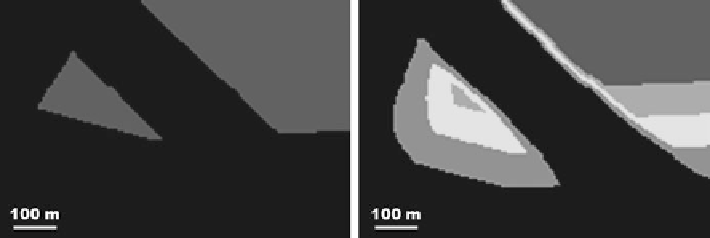Geography Reference
In-Depth Information
Fig. 1 Example of results of the crisp set analysis (
left
) and the fuzzy set analysis (
right
) (original
colour coding of the terrain:
red
—not suitable,
orange
—very limiting,
yellow
—limiting,
light
green
—acceptable,
dark green
—suitable. Grayscale version of the image shows
red
as
black
,
other colours at corresponding gray tones)
Forests
. Similarly to the trees on the banks of rivers and lakes, the obstacle
height of 20 m was assumed and the corresponding buffer zones of 190 m from
the feature boundaries were generated.
Built-up areas
. No height of this feature was assumed therefore no buffer zones
were generated and the obstacle was therefore represented by the polygon
features themselves.
Terrain slope
. The DTED 1 elevation data was used to create the terrain slope
and the parts of the terrain having the slope greater than 7
was considered as an
obstacle.
All the individual results were finally overlaid to create the output showing parts
of the terrain either suitable (green) or not suitable (red) for landing. See the
example in Fig.
1
.
Fuzzy Set Analysis of Potential HLS
As the geospatial data represent the simplified and schematic reality, the uncer-
tainty of the feature parameters was introduced to the analysis. That
led to
employing of fuzzy sets.
Roads and railroads
. Similarly to the first part of the analysis working with crisp
sets it was assumed that the height of trees or electricity poles along the features
was 10 m, but the buffer zones were not generated. The uncertainty of 2 m in
height was assumed which meant the uncertainty of
20 m in a position of the
boundary defined by the obstruction angle. The linear membership function for
roads and railroads (R) can be defined as

